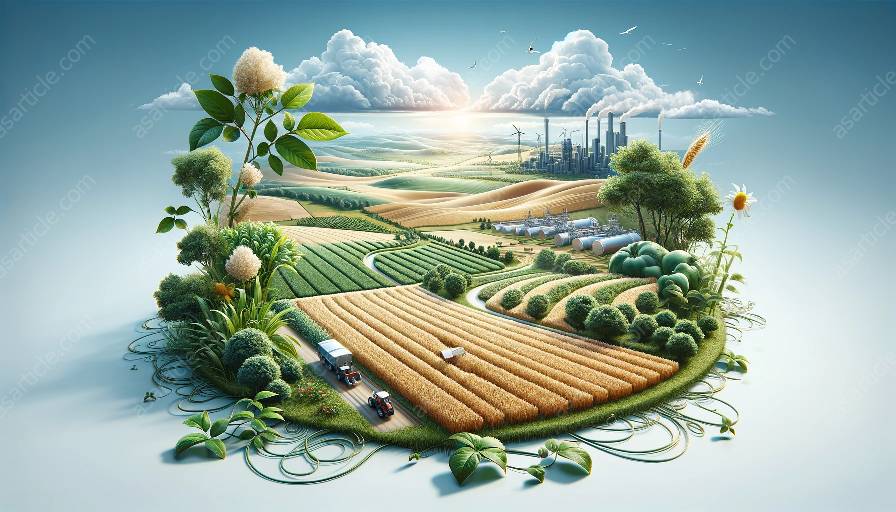As the world seeks to reduce its reliance on fossil fuels and mitigate climate change, bioenergy has emerged as a promising alternative. However, the production of bioenergy can significantly impact biodiversity, underscoring the need for sustainable solutions. This article delves into the intricate relationship between bioenergy, biodiversity, and agricultural waste management, within the context of agricultural sciences.
The Importance of Biodiversity
Biodiversity encompasses the variety of life forms within a given ecosystem, from microorganisms to plants and animals. It plays a critical role in maintaining ecological balance, resilience, and sustainability. In agricultural landscapes, biodiversity supports essential ecosystem services, such as pollination, pest control, and nutrient cycling. As such, preserving biodiversity is fundamental to ensuring the productivity and resilience of agricultural systems.
Bioenergy and Biodiversity
The production of bioenergy, derived from organic materials such as crops, agricultural residues, and forest biomass, has the potential to reduce greenhouse gas emissions and promote sustainable energy production. However, the cultivation of energy crops and the harvest of biomass can impact biodiversity, particularly if not managed with care. For instance, large-scale monoculture plantations for bioenergy feedstock can lead to habitat loss and fragmentation, endangering native species and disrupting ecological processes. Consequently, it is imperative to consider the potential impacts on biodiversity when establishing bioenergy production systems.
Sustainable Bioenergy Practices
To address the challenges posed by bioenergy production, sustainable practices that prioritize biodiversity conservation are essential. Agroforestry, which integrates trees into agricultural landscapes, not only provides biomass for bioenergy but also enhances biodiversity and ecosystem services. Additionally, adopting diverse cropping systems, such as intercropping and crop rotation, can mitigate the negative impacts of bioenergy production on biodiversity. By integrating energy crops with native vegetation and conservation areas, it is possible to minimize ecological disruptions and promote the coexistence of bioenergy production and biodiversity conservation.
Agricultural Waste Management and Bioenergy
Agricultural waste, including crop residues, manure, and other by-products, represents a valuable resource for bioenergy production. Effectively managing agricultural waste not only reduces greenhouse gas emissions from decomposition but also contributes to the generation of renewable energy. By converting agricultural residues into bioenergy, farmers can achieve greater energy independence and contribute to the transition towards a low-carbon economy.
Environmental Benefits of Waste-to-Energy
The utilization of agricultural waste for bioenergy production offers environmental benefits beyond energy generation. This practice helps prevent open burning or uncontrolled decomposition of residues, which can release pollutants and greenhouse gases into the atmosphere, contributing to air and water pollution. By implementing waste-to-energy technologies, such as anaerobic digestion and biomass combustion, agricultural waste can be transformed into biogas, biofuels, and heat, thereby reducing environmental pollution and contributing to sustainable energy production.
Role of Agricultural Sciences
Within the realm of agricultural sciences, researchers and practitioners play a pivotal role in developing sustainable bioenergy and waste management solutions. By integrating interdisciplinary approaches, such as agroecology and landscape ecology, agricultural scientists can devise strategies that simultaneously promote bioenergy production, biodiversity conservation, and agricultural waste management. Furthermore, through the advancement of crop breeding and genetics, agricultural sciences contribute to the development of energy crops that are well-suited for bioenergy production without compromising biodiversity or food security.
Integrated Landscape Management
An integrated landscape approach, informed by agricultural sciences, emphasizes the harmonization of agricultural activities with ecological processes and biodiversity conservation. By considering the spatial arrangement of agricultural lands, natural habitats, and energy production areas, integrated landscape management seeks to optimize the coexistence of bioenergy production and biodiversity. This approach encompasses not only the sustainable use of land for bioenergy cultivation but also the protection and restoration of natural ecosystems, thereby fostering a balanced and resilient landscape.
Conclusion
The symbiotic relationship between bioenergy, biodiversity, and agricultural waste management underscores the interconnectedness of these domains within the framework of agricultural sciences. As the world strives to meet its energy needs sustainably, it is imperative to embrace strategies that promote bioenergy production while safeguarding biodiversity and effectively managing agricultural waste. By leveraging the expertise of agricultural sciences and embracing holistic, sustainable practices, society can achieve a harmonious balance between bioenergy production and biodiversity conservation, contributing to a more sustainable and resilient future.

